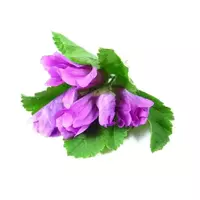Hollyhock

Of the 25 known species of this plant, Malva sylvestris is most often used for various purposes, which is widespread especially in Ukraine. Despite its name, this species also grows in vegetable gardens, on the slopes of roads and even in landfills. The official name for this plant is listed as a forest whistleblower, while it also has folk names, including wild malva or forest kalachiki.
In fact, forest malva is quite difficult to confuse with the rest of the species due to the next rounded furrowed-toothed leaves with five to seven lobes, as well as several dark purple stripes that run along each of the flower petals.
The plant is characterized by a straight branched stem, the height of which can vary from 30 to 120 centimeters and a long branched root. Saturated pink flowers can be up to four centimeters in diameter, while they are collected in bunches in the axils of leaves of 1-5 pieces.
For medicinal purposes, it is customary to collect the entire plant as a whole: not only grass with leaves, but also flowers during flowering, as well as roots that need to be dug up in late autumn. Interestingly, after collection and subsequent drying, the malva flowers acquire a dark purple color.
In culinary affairs, fresh malva leaves are most often used, which are quite suitable for food - their inhabitants of the Caucasus are used in the preparation of some dishes. In addition, fruit salads, pastries, desserts, ice cream can be decorated with attractive flowers of this plant.
Composition of Malva
All parts of the plant contain mucus, ascorbic acid, sugars, carotene and flavonoids. Tannins, aromatics and dyes were also found in the mallow. From this valuable plant, an anthocyanin glycoside was isolated, which was subsequently named after the genus - Malvin.
The Benefits of Malva
The benefits of forest malva are obvious to human health, and therefore this grass is often included in special breast fees, which can be found in homeopathic pharmacies. The use of this valuable plant is due to the enveloping, softening, exhilarating and strengthening properties of the malva.
In addition, infusions and decoctions of this plant are recommended not only to be used orally, but also to be used in the form of rinses and inhalations in the presence of cough, colds, throats and voice loss.
In traditional medicine, along with oral and respiratory tract therapy, the benefits of forest malva are relevant in relieving inflammatory processes that are observed in the esophagus, stomach, kidneys, and urinary tract.
malva 0 kCal
The energy value of malva (Ratio of proteins, fats, carbohydrates - ju):
Proteins: 0 g (~ 0 kCal)
Fats: 0 g (~ 0 kCal)
Carbohydrates: 0 g (~ 0 kCal)
 Español
Español Français
Français Português
Português Русский
Русский 简体中文
简体中文 繁體中文
繁體中文 日本語
日本語 한국어
한국어 العربية
العربية Türkçe
Türkçe Қазақ
Қазақ Deutsch
Deutsch Italiano
Italiano Українська
Українська
